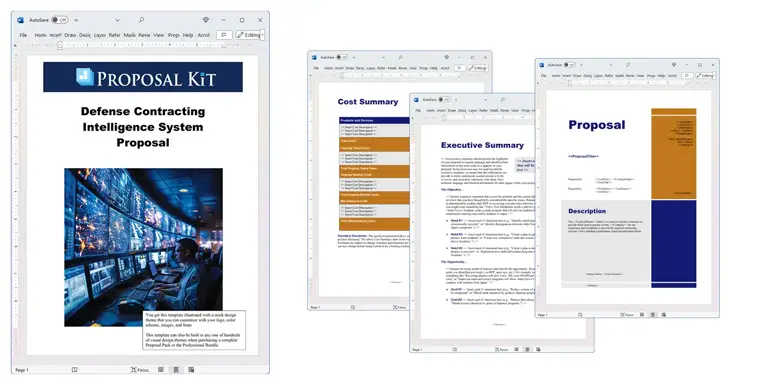How to write your Defense Contracting Intelligence System Proposal
We include this 28 page layout with every Proposal Pack. If you want this template to have a different visual design theme than the one illustrated here, purchase any Proposal Pack design and create this template using the purchased design theme. This template is included in every Proposal Pack. If you get a Proposal Pack or the Professional, you can also make any variation of this template with different chapters to suit your needs.
We typically include more chapters in the templates than most people will need to give everyone more variety in the chapters they may need. You can trim down a long template by removing pages you do not need or combining multiple chapter topics into one page.
 DOWNLOADABLE, ONE-TIME COST, NO SUBSCRIPTION FEES
DOWNLOADABLE, ONE-TIME COST, NO SUBSCRIPTION FEESYou can also create countless variations of this document to suit your needs using the included library of 2200+ chapters if ordering a Proposal Pack or Professional.
 What Our Clients Say
What Our Clients SayThe Proposal Kit benefits every client we have. It has great material on every level and is very affordable for small to medium businesses."
COO at Janus Consulting
Related Article
Related Video
Related Templates
- Security Contractor RFP Response Proposal
- Geospatial Intelligence Department Setup Proposal
- Interagency Training Center Proposal
- Government Contract for Selling Services
- DOJ Federal Government Grant Proposal #2
- DOE Federal Government Grant Proposal
- AI For Energy Management Proposal Template
- AI For Financial Fraud Detection Proposal Template
- AI Powered Educational Tools Proposal Template
- Chatbot Development Proposal Template
- Software Beta Testing Project Proposal
- Artificial Intelligence Proposal Template
- AI Based Fitness Coaching Platforms Proposal Template
- Custom Software Development Proposal
- AI Based Content Creation Proposal Template
- AI In Manufacturing For Predictive Maintenance Proposal Template
- AI Driven Social Media Analytics Proposal Template
- AI Personal Assistants for Productivity Proposal Template
- Artificial Intelligence Project Funding Proposal
- Software Licensing Sales Proposal
- FinTech System Integration Proposal Template
- Software Automation Proposal
- Machine Learning Research Proposal Template
- Software System Testing Project Proposal
- AI Driven Health Diagnostics Proposal Template
- Software Installation and Training Proposal
- AI In Legal Document Analysis Proposal Template
- Chatbot Services Proposal Template
- Software and Hardware System Proposal
- Training Services for Software Proposal
- AI For Mental Health Support Proposal Template
- AI Proposal Template
What's the Best Way to Write Your Defense Contracting Intelligence System Proposal?
A proven option for drafting a defense contracting intelligence system proposal is to utilize a Proposal Kit template and software package. This comprehensive toolkit streamlines the proposal creation process, making it accessible even to those with little to no experience in proposal writing. The Proposal Kit system includes a line item quoting database, enabling users to meticulously detail financial aspects such as cost summaries, quotes, estimates, and budgets. Proposal Kit has been designed and used for decades to create complex responses to government RFPs.
If you need to write a proposal for a defense contracting intelligence system, consider using the Proposal Kit to create your RFP response. Most proposals like this will be responses to an RFP following the guidelines of the agency issuing the RFP. The RFP will dictate your proposal layout, so the following list of chapters should be altered as needed.
What Types of Projects Are Defense Contracting Intelligence System Proposals Written For?
Defense contracting intelligence systems encompass various projects, each critical to national security and defense strategy intelligence solutions. Examples of such projects include:
- Development of encrypted communication platforms.
- Design of surveillance and reconnaissance software.
- Implementation of AI for threat detection and analysis.
- Upgrades to existing intelligence analysis systems.
- Integration of cybersecurity measures to protect classified information.
- Creation of a database for intelligence sharing among allies.
- Deployment of automated defense response systems.
- Research on new technologies for intelligence gathering.
- Training programs for the operation of intelligence systems.
- Maintenance and support services for intelligence software systems.
Chapters this template is built with
Proposal Kit offers a diverse range of templates, each designed to tackle specific aspects of a proposal, ensuring everything is noticed. For a defense contracting intelligence system proposal, relevant chapter templates include:
Cover Letter
Your cover letter is the handshake before the meeting, setting a tone of professionalism and readiness. It should introduce your organization, briefly mention your experience in defense contracting, and express your enthusiasm about the potential partnership. Since it's your first opportunity to make an impression, ensure it's courteous, concise, and compelling.
Executive Summary
The Executive Summary acts as the proposal's highlight reel, capturing the essence of your offer and its significance. It should distill the problem, your solution, and its unique benefits while emphasizing the project's strategic importance to national defense or intelligence objectives.
Cost Summary
A detailed financial plan is crucial for demonstrating your project's viability. The Cost Summary should include an itemized list of expenses, from development costs to maintenance, alongside a justification for each expense. This transparency helps build trust and shows that you've considered the financial implications of your proposal.
Competitive Analysis
In your Competitive Analysis, delineate how your offering stands out from potential competitors. Highlight your technology's superiority, cost-effectiveness, or unique features or services that give you a competitive edge. Understanding and articulating your market position is crucial for persuading decision-makers.
Goals and Objectives
Clarify the primary aims of the project in the Goals and Objectives section. Whether it's enhancing intelligence analysis capabilities, improving data security, or facilitating real-time communication among defense entities, your goals should align with the overarching needs of the agency or department you're proposing to.
Advantages
Emphasize your proposal's unique benefits, such as innovative technology solutions, unparalleled expertise, or superior customer support. This section should persuade the reader that choosing your proposal yields tangible and significant advantages.
Solutions
Detail your system's solutions, focusing on how they address the specific challenges or requirements outlined in the RFP. Be explicit about your system's functionalities and how they translate into operational benefits for the client.
Technical Approach
Describe the methodologies, frameworks, and technical specifications of your proposed system. This section should reassure the client of your solution's robustness, scalability, and suitability for their needs, highlighting any innovative technologies or approaches you plan to use.
Information Management
Explain your data handling and protection strategies, emphasizing compliance with legal and ethical standards. Your proposal should detail data storage, retrieval, and sharing mechanisms and ensure they meet defense contracting's stringent security requirements.
Safeguards
Outline the security measures and protocols you'll implement to protect the system against threats. These might include encryption, multi-factor authentication, or regular security audits, which showcase your commitment to maintaining system integrity.
System Integration
Discuss how your proposed solution will integrate with existing platforms and systems. This shows your awareness of the need for interoperability and your ability to work within the client's current technological ecosystem.
Response Time
Highlight the efficiency and reliability of your system, especially in terms of response time to threats or requests. This can be a critical factor in defense settings, where delays can have significant consequences.
Project Management
Present a clear, well-structured project management plan outlining timelines, milestones, and roles. This will demonstrate your organizational capabilities and commitment to delivering the project on schedule and within budget.
Intelligence
Detail how your system will enhance intelligence gathering, analysis, or dissemination capabilities. Specific examples or case studies can be particularly persuasive in this section.
Technology
Provide a deep dive into the technologies employed in your solution, explaining how they contribute to the project's goals and objectives. This might include artificial intelligence, machine learning, or blockchain technologies.
Specifications
Offer a comprehensive list of technical and operational specifications your system will meet or exceed. This will reassure the client that your solution is up to the task and meets their requirements.
Recommendations
Conclude with a solid call to action, summarizing your proposal's key points and suggesting clear next steps. This reinforces your eagerness to progress with the project and your confidence in your solution.
Capabilities
Showcase your company's strengths and track record in the defense sector. This will build credibility and reassure the client of your ability to deliver as promised.
Qualifications
Highlight the expertise and experience of your team, particularly in areas relevant to the project. This can include previous defense projects, specific technical skills, or security clearance levels.
Company History
Share your company's background, focusing on successes and milestones demonstrating your reliability and commitment to excellence in defense contracting.
Security Clearance
Confirm that your team has the necessary security clearances to handle sensitive information, underscoring your capability to work on defense projects.
Comparison Chart
Use a comparison chart to visually differentiate your solution from others and highlight your competitive advantages clearly and concisely.
Team Members
Introduce the project team, emphasizing their roles, expertise, and how they contribute to the project's success. This personalizes your proposal and helps build a connection with
Use cases for this template
Elena's Achievement with SecureTech Innovations
Elena's journey began when she identified a niche in national defense that SecureTech Innovations could fill with its cutting-edge intelligence system. The project required technical expertise and a deep understanding of the defense sector's unique needs and stringent security requirements. Facing competitors with more extensive resources and established reputations, Elena knew that her proposal needed to stand out for its technical merits and strategic insight.
Using the Proposal Kit, Elena was able to structure her proposal to highlight SecureTech's agility, innovative solutions, and readiness to meet complex challenges. She emphasized the company's commitment to security, detailing advanced safeguards and compliance with military-grade protocols, which was crucial for winning the trust of the defense contracting board. The Proposal Kit templates also helped her effectively showcase her team's qualifications, including their specialized skills and clearances, framing SecureTech as a company that, while small, packed a significant punch in technological prowess and security expertise.
The victory was not just a business win for SecureTech but a validation of Elena's vision and the capabilities of her nimble team. It underscored the power of a well-written proposal and the strategic advantage provided by Proposal Kit in articulating a compelling narrative that resonates with the client's specific needs and concerns and following all the rules of the RFP.
Liam's Sprint with Cipher Dynamics
Cipher Dynamics was on the verge of a breakthrough in defense intelligence systems when an RFP with a tight submission deadline was announced. Liam, leading the proposal effort, faced the colossal task of compiling a comprehensive and technically detailed proposal in a fraction of the usual time. The pressure was immense, with the potential contract as a pivotal moment for Cipher Dynamics to showcase its innovation on a grand stage.
Integrating Proposal Kit's output with an AI writing tool proved to be a game-changer for Liam. While the Proposal Kit provided a robust structure and ensured all proposal elements were methodically addressed - from the technical approach and system integration to safeguards and project management - the AI tool offered speed, generating draft content pulled from their project documentation that Liam could refine and adapt. This combination allowed for a highly efficient proposal development process, enabling Liam to focus on customizing the proposal to perfectly match the RFP's requirements and Cipher Dynamics' strengths.
Liam's ability to deliver a comprehensive, persuasive proposal under such tight constraints demonstrated the agility and innovation at Cipher Dynamics' heart. It was also a testament to the effectiveness of leveraging the right tools for the task, showcasing how the Proposal Kit can complement technological solutions to achieve remarkable results.
Sophia's Global Directive at Worldwide Defense Agency
The Worldwide Defense Agency's initiative to develop a global intelligence system was ambitious and required a broad vision and meticulous attention to detail. Sophia, leading the RFP development, needed to create a document that was comprehensive and sensitive to the varied needs and standards of international stakeholders.
Sophia's use of the Proposal Kit allowed her to write a detailed and flexible RFP capable of guiding responses from various global contractors. She utilized the software to ensure that every aspect of the intelligence system - from technology and specifications to safeguards and project management - was clearly defined, setting a high bar for proposals.
The RFP articulated a vision for a system that would enhance global intelligence capabilities, emphasizing the need for innovative solutions, robust security measures, and seamless integration with existing platforms. Through the Proposal Kit, Sophia addressed complex compliance requirements and diverse operational contexts, presenting a clear, unified framework for potential contractors.
The result was a highly effective RFP that attracted competitive bids, paving the way for a project that would significantly enhance global defense and intelligence collaboration. Sophia's success illustrated the power of a well-constructed RFP and the indispensable role of Proposal Kit in achieving clarity, precision, and reach in global defense contracting efforts.
Conclusions and Recommendations
Proposal Kit is an indispensable tool for navigating the complexities of defense contracting proposals. Proposal Kit offers a structured, efficient path to writing proposals that resonate with stakeholders and meet stringent requirements.
Also Known As
This template may also be referred to in different ways or be used in more specialized situations, such as:
- Defense Procurement Analysis Solution Proposal
- Military Contracting Advisory System Proposal
- Defense Acquisition Intelligence Framework Proposal
- National Security Contracting Strategy Proposal
- Armed Forces Procurement Insight System Proposal
- Defense Sector Contract Analysis Initiative Proposal
- Military Vendor Intelligence System Proposal
- Defense Contract Oversight Solution Proposal
- Strategic Defense Procurement System Proposal
- Military Contract Intelligence and Advisory Proposal
Abstract
 Developing a proposal for a defense contracting intelligence system requires precision and insight to align with government contracting standards. Proposal Kit assists in creating proposals that meet federal government requirements, using advanced analytics and data analysis to enhance visibility and prepare for successful proposal submission. By integrating components like a detailed cost summary, competitive analysis, and a comprehensive project management plan, businesses can manage their proposal preparation process. These proposals cover a wide range of projects, from system integration to cybersecurity measures, underscoring their vital role in supporting the intelligence community and government agencies. Success in this field can yield significant awards issued by the Department of Defense, exemplifying the importance of managing task orders and clauses for government contracts.
Developing a proposal for a defense contracting intelligence system requires precision and insight to align with government contracting standards. Proposal Kit assists in creating proposals that meet federal government requirements, using advanced analytics and data analysis to enhance visibility and prepare for successful proposal submission. By integrating components like a detailed cost summary, competitive analysis, and a comprehensive project management plan, businesses can manage their proposal preparation process. These proposals cover a wide range of projects, from system integration to cybersecurity measures, underscoring their vital role in supporting the intelligence community and government agencies. Success in this field can yield significant awards issued by the Department of Defense, exemplifying the importance of managing task orders and clauses for government contracts.
A well-written proposal serves as more than just a request for funding; it is a vital report that articulates a company's qualifications and capabilities in the defense sector. Business development in this industry demands a full range of intelligence support services, including managing detailed technical approaches and safeguarding information management. Companies differentiate themselves by showcasing their expertise in automation and their ability to adapt to the reality of the defense sector's demands, ensuring their solutions qualify for federal contracting. The directorate leaders in these organizations recognize the difference a proposal can make, not only in securing actual contracts but also in establishing long-term partnerships with other industry leaders.
Strategically, proposal teams must emphasize their strengths in scientific and technological advancements to stand out in a competitive marketplace. Highlighting innovative solutions through technical specifications and system integration capabilities helps secure approval from decision-makers. The struggle to meet tight deadlines can be alleviated by using Proposal Kit, which provides a structured approach to tackling complex proposals. This approach allows companies to demonstrate their readiness and agility, ultimately leading to more business opportunities and significant financial gains.
 By focusing on the needs and objectives of the federal government and the intelligence community, organizations can create proposals that not only meet but exceed expectations. This ensures that they remain at the forefront of defense industry innovations and maintain a competitive edge in securing lucrative contracts.
By focusing on the needs and objectives of the federal government and the intelligence community, organizations can create proposals that not only meet but exceed expectations. This ensures that they remain at the forefront of defense industry innovations and maintain a competitive edge in securing lucrative contracts.
Creating a successful proposal for a defense contracting intelligence system involves meticulous planning and business development. The Proposal Kit has emerged as an indispensable tool in this process, providing a comprehensive framework for proposal teams working with government agencies. By using this toolkit, companies can address the complex clauses and stipulations often present in federal contracting, ensuring their proposals meet the stringent requirements of the federal government and the defense intelligence agency.
Proposal Kit aids in managing the detailed process of proposal submission by offering templates that cover a full range of necessary components. These include a technically robust system integration plan and a thorough examination of advanced analytics capabilities, which are crucial for demonstrating the company's ability to innovate and meet national security objectives. In addition to facilitating the preparation of detailed cost summaries and competitive analyses, the toolkit supports the incorporation of automation to streamline proposal development, thus saving time and money.
 Considering the situation of government contracts, maintaining a high level of visibility is critical. The Proposal Kit helps companies to systematically manage their documentation, enhancing their ability to respond promptly to task orders and qualify for awards issued by the Department of Defense. This approach not only helps secure immediate project funding but also strengthens long-term relationships with partners across the industry.
Considering the situation of government contracts, maintaining a high level of visibility is critical. The Proposal Kit helps companies to systematically manage their documentation, enhancing their ability to respond promptly to task orders and qualify for awards issued by the Department of Defense. This approach not only helps secure immediate project funding but also strengthens long-term relationships with partners across the industry.
Moreover, the importance of a clear and compelling executive summary cannot be overstated. It synthesizes the proposal's intentions and aligns them with the overarching goals of the intelligence community. By emphasizing unique advantages such as technological innovation and superior professional services, companies can persuasively convey their distinct value proposition to stakeholders. This includes showcasing their capability in managing data analysis and providing intelligence support services that are vital to achieving decisive outcomes in defense initiatives.
Finally, the proposal must address potential risks and outline safeguards to mitigate them, incorporating preventive measures and contingency plans that reflect the company's commitment to maintaining security and compliance. Leaders within the organization must ensure that their proposals articulate a clear understanding of both the scientific and operational realities of the defense sector, ultimately making a substantial difference in the approval and success of their submissions. By doing so, they position themselves as industry frontrunners, ready to tackle the challenges of defense contracting with confidence and expertise.
Frequently Asked Questions
What should a defense contracting intelligence system proposal include?
A comprehensive defense contracting intelligence system proposal should include an executive summary, an introduction outlining the purpose and scope, a detailed description of the system's features and capabilities, a section on the methodology and data sources, an analysis of the expected benefits and impact, a timeline and project plan, and a budget. Additionally, it should address compliance with relevant regulations and standards and include a risk management plan.
How can I ensure my proposal meets all regulatory and compliance requirements?
To ensure compliance, thoroughly research and understand all relevant regulations and standards for defense contracting, such as the Federal Acquisition Regulation (FAR) and Defense Federal Acquisition Regulation Supplement (DFARS). Incorporate these requirements into your proposal by clearly documenting how your system adheres to these standards. Consulting with legal and compliance experts can help verify that all aspects of the proposal align with current regulations.
What are the best practices for demonstrating the value and benefits of the proposed system?
Clearly articulate the specific problems the system will solve and the tangible benefits it will provide, such as improved decision-making, cost savings, enhanced security, and operational efficiency. Use data, case studies, and examples to back up your claims. Including metrics and key performance indicators (KPIs) that will be used to measure success can also strengthen your argument and demonstrate the system's value.
How detailed should the proposal's project timeline and budget be?
The project timeline and budget should be detailed enough to provide a realistic and clear action plan. Break down the timeline into critical phases and milestones, specifying the duration and objectives of each phase. For the budget, include a detailed cost breakdown covering all aspects of the project, such as personnel, technology, software, training, and contingency funds. Providing this level of detail helps build credibility and shows that you have thoroughly planned the project.
How can I address potential risks in my proposal?
Identify and analyze potential risks that could impact the project, such as financial, technical, operational, and compliance-related risks. Provide a risk management plan that outlines strategies for mitigating these risks. This plan should include preventive measures, contingency plans, and risk monitoring processes. Demonstrating a proactive approach to risk management reassures stakeholders of your capability to handle challenges and ensures project success.
20% Off Discount
![]() Add To Cart This Word Template
Add To Cart This Word Template
 Add To Cart Proposal Pack for Any Business
Add To Cart Proposal Pack for Any Business
 Add To Cart Proposal Kit Professional
Add To Cart Proposal Kit Professional
 4.7 stars, based on 849 reviews
4.7 stars, based on 849 reviewsProposal Kit chapters used in this template
Cover Letter, Title Page, Table of Contents, Executive Summary, Goals and Objectives, Intelligence, Solutions, Comparison Chart, Advantages, Competitive Analysis, Technology, Information Management, Technical Approach, System Integration, Response Time, Safeguards, Project Management, Specifications, Cost Summary, Team Members, Security Clearance, Recommendations, Company History, Qualifications, Capabilities, Compliance Matrix, RFP Cross Reference, Back Page
Line Item Automated Chapters
If you purchase a Proposal Pack or the Professional Bundle, these proposal pages are generated using an automated line-item database in the included Wizard software.
Cost Summary
You use this proposal for
- General business proposal
- Technical proposal
- Service sales proposal
- RFP response
- Government contract proposal
- IT, software, hardware proposal
- Security, safety, protection, investigation proposal
How to create this template with Proposal Pack Wizard
You can create this document using any of the logo-designed Proposal Packs. Pick any Proposal Pack with a logo design theme you like best; they will all work equally well. The Proposal Pack for Any Business is the pack with no extra added logos or colors - designed to be used plain or for you to customize with your logos and graphics.
The Proposal Pack design theme you purchase will determine the visual look of this template. The screenshot above only shows the plain generic design theme.
We include a library of chapters to be assembled based on your needs. All proposals are different and have different needs and goals. We designed Proposal Pack so you can customize the documents to suit your needs.
You will best create this document using the Proposal Pack Wizard - Expert Edition software to select this template and build it in the Proposal Pack logo design theme of your choice along with any desired customizations (such as adding additional chapters, removing unneeded chapters, changing the order of chapters, and importing your company logo). This template outlines a proposal for the described situation. Each user is responsible for typing in the actual content of the provided pages with their information to complete the proposal. Suggestions in the abstract may include features in higher-end packages and are facilitated by the selection of chapter templates to support the narrative of each proposal, which help guide the user in filling in the details.
The Wizard software's AI Writer will write the content of the pages of the template based on details provided for your company, client, project, financial details and other writing instructions. This will provide a personalized version of the template completely written and ready to edit.
Once finished, the AI Writer's Word-to-PowerPoint converter can transform your proposal, business plan, or other business documents into a PowerPoint slideshow. Save time and effort by letting the AI analyze every chapter to condense its content into talking points, visually matching the document, and providing a consistent package of presentation material with the click of a button.
You create this template using the Wizard software with an entire Proposal Pack library and software. We include the Expert Edition of the software in the Proposal Kit Professional. Microsoft Word for Windows is required to use the customizing software. You can also edit Word document templates in other office software such as Word for Mac. We will assist Mac users in assembling complex templates for their first project if they do not have the required platform to run the Wizard software.
How to Build Templates Featured on Proposal Kit Website
Many people find the Proposal Kit website after searching for a specific proposal. Once you've purchased and installed the software, how do you build that template you found in the first place? This video shows you how to build any proposal you see on the Proposal Kit website.
 Ian Lauder has been helping businesses write their proposals and contracts for two decades. Ian is the owner and founder of Proposal Kit, one of the original sources of business proposal and contract software products started in 1997.
Ian Lauder has been helping businesses write their proposals and contracts for two decades. Ian is the owner and founder of Proposal Kit, one of the original sources of business proposal and contract software products started in 1997.By Ian Lauder
 Published by Proposal Kit, Inc.
Published by Proposal Kit, Inc.


 Cart
Cart
 Get 20% off ordering today:
Get 20% off ordering today: 


 Facebook
Facebook YouTube
YouTube Bluesky
Bluesky Search Site
Search Site